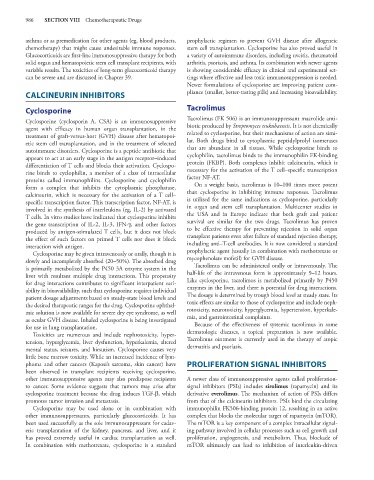Page 1000 - Basic _ Clinical Pharmacology ( PDFDrive )
P. 1000
986 SECTION VIII Chemotherapeutic Drugs
asthma or as premedication for other agents (eg, blood products, prophylactic regimen to prevent GVH disease after allogeneic
chemotherapy) that might cause undesirable immune responses. stem cell transplantation. Cyclosporine has also proved useful in
Glucocorticoids are first-line immunosuppressive therapy for both a variety of autoimmune disorders, including uveitis, rheumatoid
solid organ and hematopoietic stem cell transplant recipients, with arthritis, psoriasis, and asthma. Its combination with newer agents
variable results. The toxicities of long-term glucocorticoid therapy is showing considerable efficacy in clinical and experimental set-
can be severe and are discussed in Chapter 39. tings where effective and less toxic immunosuppression is needed.
Newer formulations of cyclosporine are improving patient com-
CALCINEURIN INHIBITORS pliance (smaller, better-tasting pills) and increasing bioavailability.
Cyclosporine Tacrolimus
Tacrolimus (FK 506) is an immunosuppressant macrolide anti-
Cyclosporine (cyclosporin A, CSA) is an immunosuppressive
agent with efficacy in human organ transplantation, in the biotic produced by Streptomyces tsukubaensis. It is not chemically
treatment of graft-versus-host (GVH) disease after hematopoi- related to cyclosporine, but their mechanisms of action are simi-
etic stem cell transplantation, and in the treatment of selected lar. Both drugs bind to cytoplasmic peptidylprolyl isomerases
autoimmune disorders. Cyclosporine is a peptide antibiotic that that are abundant in all tissues. While cyclosporine binds to
appears to act at an early stage in the antigen receptor–induced cyclophilin, tacrolimus binds to the immunophilin FK-binding
differentiation of T cells and blocks their activation. Cyclospo- protein (FKBP). Both complexes inhibit calcineurin, which is
rine binds to cyclophilin, a member of a class of intracellular necessary for the activation of the T cell–specific transcription
proteins called immunophilins. Cyclosporine and cyclophilin factor NF-AT.
form a complex that inhibits the cytoplasmic phosphatase, On a weight basis, tacrolimus is 10–100 times more potent
calcineurin, which is necessary for the activation of a T cell– than cyclosporine in inhibiting immune responses. Tacrolimus
specific transcription factor. This transcription factor, NF-AT, is is utilized for the same indications as cyclosporine, particularly
involved in the synthesis of interleukins (eg, IL-2) by activated in organ and stem cell transplantation. Multicenter studies in
T cells. In vitro studies have indicated that cyclosporine inhibits the USA and in Europe indicate that both graft and patient
the gene transcription of IL-2, IL-3, IFN-γ, and other factors survival are similar for the two drugs. Tacrolimus has proven
produced by antigen-stimulated T cells, but it does not block to be effective therapy for preventing rejection in solid organ
the effect of such factors on primed T cells nor does it block transplant patients even after failure of standard rejection therapy,
interaction with antigen. including anti–T-cell antibodies. It is now considered a standard
Cyclosporine may be given intravenously or orally, though it is prophylactic agent (usually in combination with methotrexate or
slowly and incompletely absorbed (20–50%). The absorbed drug mycophenolate mofetil) for GVH disease.
is primarily metabolized by the P450 3A enzyme system in the Tacrolimus can be administered orally or intravenously. The
liver with resultant multiple drug interactions. This propensity half-life of the intravenous form is approximately 9–12 hours.
for drug interactions contributes to significant interpatient vari- Like cyclosporine, tacrolimus is metabolized primarily by P450
ability in bioavailability, such that cyclosporine requires individual enzymes in the liver, and there is potential for drug interactions.
patient dosage adjustments based on steady-state blood levels and The dosage is determined by trough blood level at steady state. Its
the desired therapeutic ranges for the drug. Cyclosporine ophthal- toxic effects are similar to those of cyclosporine and include neph-
mic solution is now available for severe dry eye syndrome, as well rotoxicity, neurotoxicity, hyperglycemia, hypertension, hyperkale-
as ocular GVH disease. Inhaled cyclosporine is being investigated mia, and gastrointestinal complaints.
for use in lung transplantation. Because of the effectiveness of systemic tacrolimus in some
Toxicities are numerous and include nephrotoxicity, hyper- dermatologic diseases, a topical preparation is now available.
tension, hyperglycemia, liver dysfunction, hyperkalemia, altered Tacrolimus ointment is currently used in the therapy of atopic
mental status, seizures, and hirsutism. Cyclosporine causes very dermatitis and psoriasis.
little bone marrow toxicity. While an increased incidence of lym-
phoma and other cancers (Kaposi’s sarcoma, skin cancer) have PROLIFERATION SIGNAL INHIBITORS
been observed in transplant recipients receiving cyclosporine,
other immunosuppressive agents may also predispose recipients A newer class of immunosuppressive agents called proliferation-
to cancer. Some evidence suggests that tumors may arise after signal inhibitors (PSIs) includes sirolimus (rapamycin) and its
cyclosporine treatment because the drug induces TGF-β, which derivative everolimus. The mechanism of action of PSIs differs
promotes tumor invasion and metastasis. from that of the calcineurin inhibitors. PSIs bind the circulating
Cyclosporine may be used alone or in combination with immunophilin FK506-binding protein 12, resulting in an active
other immunosuppressants, particularly glucocorticoids. It has complex that blocks the molecular target of rapamycin (mTOR).
been used successfully as the sole immunosuppressant for cadav- The mTOR is a key component of a complex intracellular signal-
eric transplantation of the kidney, pancreas, and liver, and it ing pathway involved in cellular processes such as cell growth and
has proved extremely useful in cardiac transplantation as well. proliferation, angiogenesis, and metabolism. Thus, blockade of
In combination with methotrexate, cyclosporine is a standard mTOR ultimately can lead to inhibition of interleukin-driven

